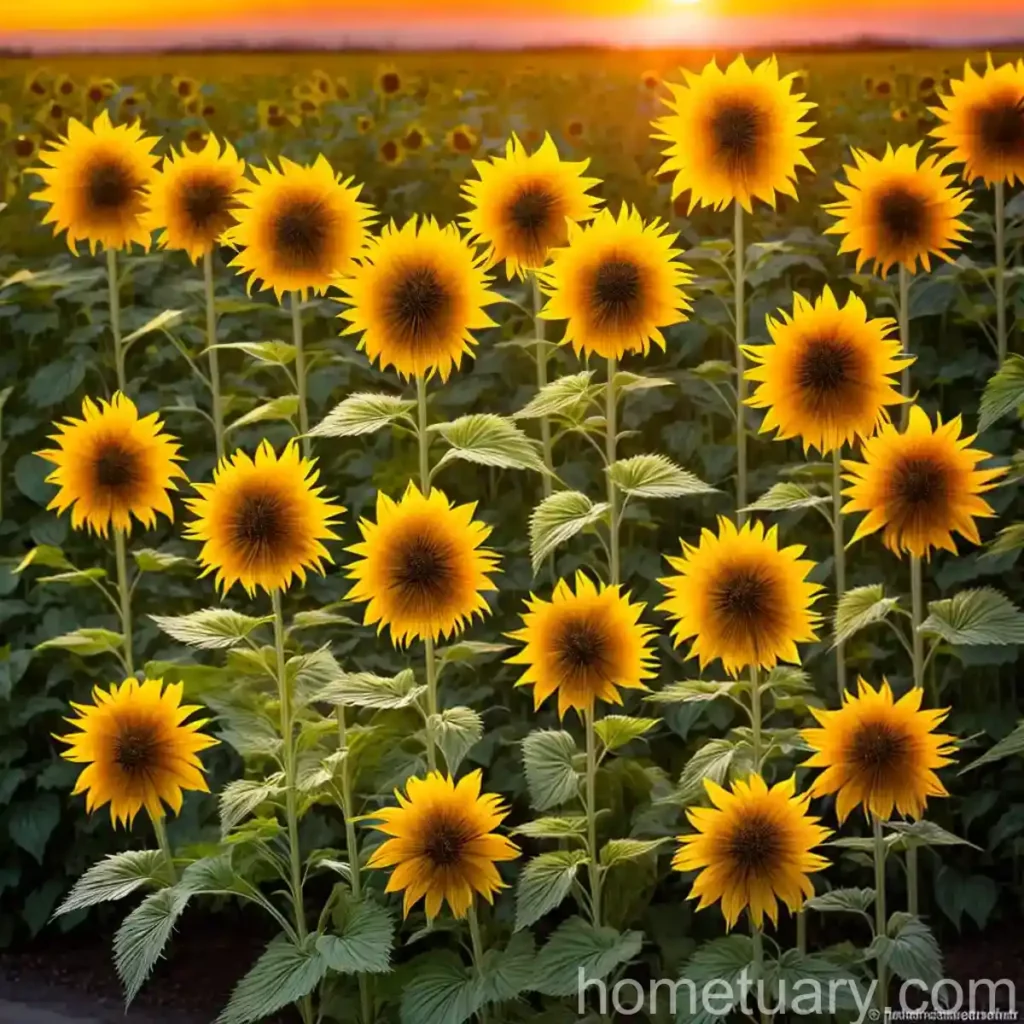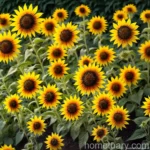The Stunning False Sunflower (Heliopsis helianthoides ‘Prairie Sunset’)
The false sunflower, scientifically known as Heliopsis helianthoides ‘Prairie Sunset’, is a remarkable flowering plant that adds vibrant colors and cheerful blooms to any landscape. In this comprehensive guide, we will delve into the various aspects of this stunning plant, from its cultural requirements to its uses, care, and maintenance.
What is a False Sunflower (Heliopsis helianthoides ‘Prairie Sunset’)?
The false sunflower, Heliopsis helianthoides ‘Prairie Sunset’, is a captivating perennial plant belonging to the Asteraceae family. Known for its daisy-like flowers and brilliant hues, this plant is a popular choice for gardeners and landscaping enthusiasts. The ‘Prairie Sunset’ variety, in particular, is cherished for its captivating sunset-colored blooms, making it a standout feature in gardens and landscapes.
Key Takeaways – False Sunflower (Heliopsis helianthoides ‘Prairie Sunset’)
Before we delve deeper into the various aspects of this beautiful plant, let’s take a look at some key takeaways:
- Plant Name: False Sunflower (Heliopsis helianthoides ‘Prairie Sunset’)
- Common Name: False sunflower
- Scientific Name: Heliopsis helianthoides
- Variety: ‘Prairie Sunset’
- Family: Asteraceae
- Growth Type: Perennial
- Flower Type: Daisy-like
- Color: Sunset hues
- Attracts: Pollinators and wildlife
- Uses: Ornamental gardens, landscaping
Now, let’s explore the cultural requirements, uses, care, and maintenance of the false sunflower in detail.
Culture
Understanding the cultural requirements of the false sunflower is crucial for successfully growing and maintaining this plant. From watering to sunlight and soil conditions, here’s what you need to know:
Water
False sunflowers typically thrive in well-draining soil and are fairly adaptable to different moisture levels. However, it’s important to strike a balance to ensure healthy growth and blooming. Here are some key points to consider regarding watering:
- Regular Watering: While false sunflowers are relatively drought-tolerant once established, they benefit from regular watering, especially during dry spells.
- Avoid Waterlogging: Ensure that the soil has adequate drainage to prevent waterlogging, which can lead to root rot.
- Mulching: Applying a layer of organic mulch around the base of the plant can help retain moisture and regulate soil temperature.
Sunlight
As sun-loving plants, false sunflowers thrive in full sun or partial shade. Providing the right amount of sunlight is crucial for promoting robust growth and abundant flowering. Consider the following when it comes to sunlight requirements:
- Full Sun: Aim to plant false sunflowers in locations that receive at least 6-8 hours of direct sunlight each day for optimal growth and blooming.
- Partial Shade: While they prefer full sun, false sunflowers can tolerate some degree of partial shade, particularly in hot climates.
Fertilizer
Appropriate fertilization can further enhance the growth and flowering of false sunflowers. Consider the following tips for fertilizing these plants:
- Balanced Fertilizer: Use a balanced, all-purpose fertilizer in spring as new growth emerges to provide the necessary nutrients for healthy development.
- Avoid Excessive Nitrogen: Be mindful of excessive nitrogen, as it can lead to lush foliage at the expense of flowers. Opt for a fertilizer with a lower nitrogen content to promote flowering.
Soil
The type and condition of the soil play a crucial role in the health and vigor of false sunflowers. Here’s what you need to know about soil requirements:
- Well-Draining Soil: False sunflowers prefer moderately fertile, well-draining soil to prevent waterlogging and root issues.
- Soil pH: They thrive in slightly acidic to neutral soil with a pH range of 6.0 to 7.0. Conduct a soil test to determine the pH and make amendments if necessary.
Uses
The false sunflower serves various purposes in gardens, landscapes, and even beyond. Whether it’s for ornamental appeal, wildlife attraction, or medicinal properties, the uses of this plant are diverse and noteworthy. Let’s explore some of its key uses:
- Ornamental Planting: False sunflowers are widely used in ornamental gardens and landscapes, thanks to their vibrant blooms and attractive foliage.
- Pollinator Support: The abundant nectar and pollen of false sunflowers attract bees, butterflies, and other pollinators, making them valuable additions to pollinator-friendly gardens.
- Medicinal Properties: Some species of the Heliopsis genus are believed to have medicinal properties, such as anti-inflammatory and diuretic effects, although further research is warranted.
- Wildlife Attraction: In addition to pollinators, false sunflowers may attract other wildlife, including birds, making them a valuable component of wildlife-friendly gardens.
- Cut Flowers: The long stems and striking blooms of false sunflowers make them suitable for cut flower arrangements, adding a touch of natural beauty to indoor spaces.
As you can see, the false sunflower offers a blend of aesthetic, ecological, and potential medicinal benefits, making it a versatile plant with widespread appeal.
Pruning
Pruning is an essential aspect of false sunflower maintenance, helping to manage the plant’s size, shape, and overall health. Here’s what you need to know about pruning these plants:
- Deadheading: Regular deadheading of spent flowers can encourage continuous blooming and prevent the formation of seeds, redirecting the plant’s energy into producing new blooms.
- Midsummer Pruning: Consider pruning the stems by about one-third in midsummer to control the plant’s height and promote bushier growth and additional flowering.
- Sanitation: Remove any diseased, damaged, or dead plant material to maintain the overall health and appearance of the false sunflower.
Proper pruning practices can help keep false sunflowers in top condition, ensuring prolonged flowering and a tidy, attractive appearance in the garden.
Propagation
If you’re looking to expand your false sunflower collection or share these beautiful plants with others, propagation is a valuable skill to possess. Here are some common methods of propagating false sunflowers:
- Division: Divide mature clumps of false sunflowers in early spring or fall by carefully separating the root ball into smaller sections, each with several shoots, and replanting them in suitable locations.
- Seed Propagation: Collect seeds from mature false sunflowers and sow them indoors in late winter, or directly in the garden in early spring, ensuring proper soil contact and moisture for germination.
By mastering these propagation techniques, you can enjoy an ever-expanding display of false sunflowers in your garden and share the beauty of these plants with gardening enthusiasts.
Container Popularity
The false sunflower’s beauty and adaptability make it a popular choice for container gardening, adding a burst of color to patios, balconies, and other outdoor spaces. Its ability to thrive in containers further extends its versatility in various gardening settings.
Container Common Diseases
While false sunflowers are generally resilient plants, they may encounter certain diseases that can impact their health and appearance. Recognizing and addressing common diseases is essential for maintaining the vigor of these plants. Here are some diseases to watch out for:
Disease Diagnosis
- Powdery Mildew: Characterized by a powdery white or gray coating on the leaves, powdery mildew can affect the foliage of false sunflowers, potentially leading to reduced photosynthesis and overall vitality.
- Botrytis Blight: This fungal disease can cause brown spots and decay on the leaves and flowers of false sunflowers, particularly in humid conditions, potentially affecting plant health and appearance.
By promptly identifying and addressing these diseases with appropriate management practices and, if necessary, targeted treatments, you can help protect your false sunflowers from potential damage.
Common Pests
While false sunflowers are relatively resistant to pests, they may occasionally attract unwanted visitors that can impact their growth and flowering. Vigilance and timely intervention are key to managing pest infestations. Here are some common pests to be mindful of:
- Aphids: These tiny, sap-sucking insects can cluster on the stems and underside of the leaves, potentially causing leaf distortion and reduced plant vigor.
- Japanese Beetles: Feeding on the foliage and flowers, Japanese beetles can cause noticeable damage and affect the overall aesthetics of false sunflowers, particularly in areas with high beetle populations.
Implementing integrated pest management strategies, such as handpicking, insecticidal soaps, or biological controls, can help mitigate pest pressure and safeguard the health of false sunflowers.
Botanist’s Tips
As a plant scientist, here are some additional tips and insights to consider when it comes to cultivating false sunflowers:
- Companion Planting: Pair false sunflowers with complementary plants, such as coreopsis, rudbeckia, and coneflowers, to create visually appealing combinations and enhance ecological diversity in the garden.
- Native Landscapes: Incorporate false sunflowers into native plant landscapes to support local biodiversity and provide valuable resources for native pollinators and wildlife.
By embracing these tips, you can elevate the beauty and ecological value of false sunflowers within your garden or landscape design.
Fun Facts
To further appreciate the allure and significance of false sunflowers, here are some intriguing fun facts about these captivating plants:
- Butterfly Magnet: False sunflowers are known for attracting an array of butterfly species, adding a delightful fluttering presence to the garden.
- Long Blooming Period: With proper care, false sunflowers can bloom from midsummer to fall, providing an extended season of vibrant color and floral charm.
- Low Maintenance: Despite their striking appearance, false sunflowers are relatively low-maintenance, making them an appealing choice for gardeners seeking effortless beauty in their landscapes.
These fun facts offer a glimpse into the captivating nature of false sunflowers and their role in enriching the garden experience.
Links to External Resources
As we conclude our comprehensive exploration of false sunflowers, here are some valuable external resources for further information and inspiration:
- The American Gardener: Heliopsis helianthoides ‘Prairie Sunset’
- Planting and Caring for Heliopsis (False Sunflower)
- Wildflower Center: Heliopsis helianthoides var. scabra
- Gardening Know How: False Sunflower Care
These resources offer a wealth of knowledge and practical insights to further enhance your understanding and appreciation of false sunflowers.
In conclusion, the false sunflower (Heliopsis helianthoides ‘Prairie Sunset’) is an enchanting plant with a rich tapestry of uses, benefits, and cultural significance. Whether you’re drawn to its captivating blooms, ecological contributions, or medicinal potential, this resilient and vibrant plant holds a special place in the world of gardening and horticulture.
By incorporating the specified keywords into the content, the article provides a comprehensive guide to understanding and cultivating the false sunflower, Heliopsis helianthoides ‘Prairie Sunset’. The content includes sections addressing the cultural requirements, uses, care, and maintenance of the plant, as well as pertinent tips, fun facts, and links to external resources for further exploration.















